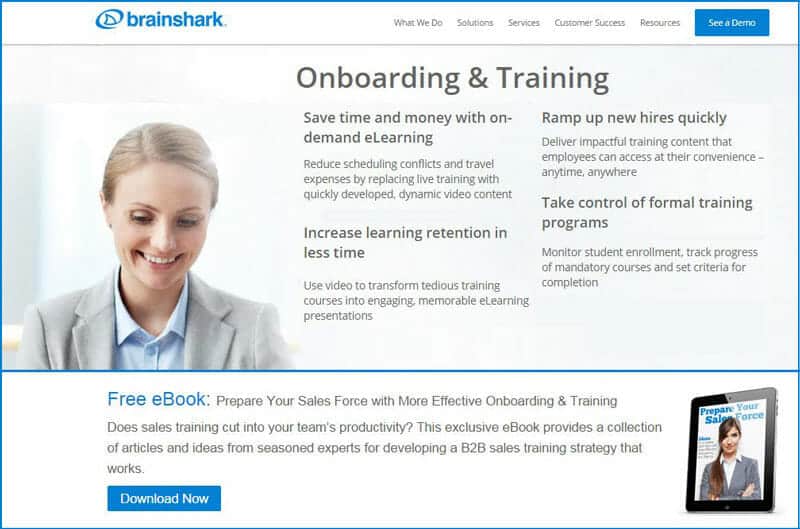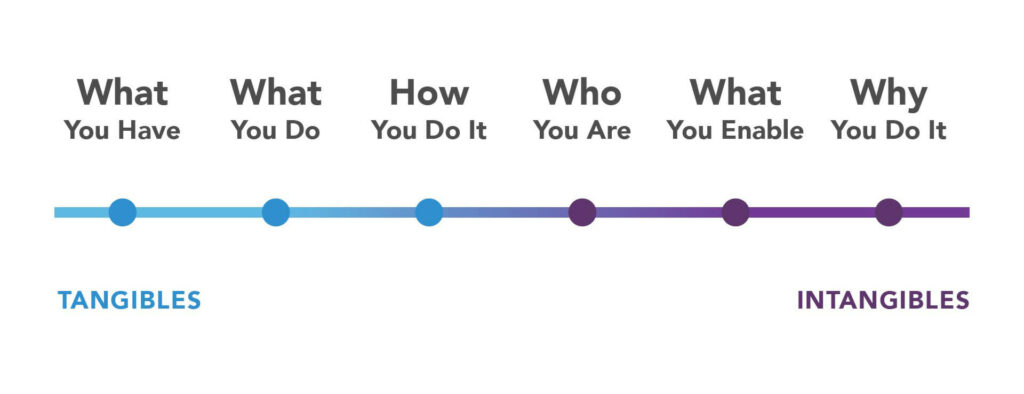Today’s B2B leaders confront an unforgiving reality: mounting pressure to defend margins, accelerate growth, and retain customers and employees in increasingly competitive markets.
Many factors contribute to these challenges:
- Lower switching costs, endless alternatives: Digital transformation has made features easier to replicate, reducing barriers to change
- Heightened investor scrutiny: Economic uncertainty means every investor relationship carries more weight
- The battle for top talent: Remote work has expanded the talent pool—and the competition for elite professionals
To compete, brands need to build emotional connections with their audiences. They must move people to perceive and experience the company as integral to their own success, something that makes them far less likely to comparison shop.
To achieve this transformation, you need to build brand affinity.
What is Brand Affinity?
Brand affinity is the emotional connection that turns customers from transactional buyers into invested partners in the company’s success. A simpler brand affinity definition: it’s when customers see your company as essential to their own growth, fulfillment, and achievement, not just a provider of goods or services.
Deeper and more resilient than basic loyalty, brand affinity builds relationships that endure market shifts, leadership changes, and competitive pressures. It is particularly valuable during business transformations—whether you are repositioning after a merger, entering new markets, or expanding your service offerings—to reinforce both new and existing ties.
Loyalty vs. Affinity: Why Emotional Bonds Matter
Traditional customer loyalty focuses on repeat transactions. But loyalty alone—while valuable—often stems from routine purchasing behaviors or short-term incentives. In B2B, where relationships last years, it can be fragile, vulnerable to competitors offering better pricing or greater convenience.
Brand affinity is rooted in shared values and emotional investment, making it far more durable than brand loyalty. Rather than purchasing out of habit or being easily incentivized by rewards, customers with brand affinity choose you because they believe in you. They see your business as an extension of their own values and goals.
This creates a relationship that transcends transactional decision making. When customers feel authentic affinity for your brand, they will more reliably:
- Stay with you through business evolutions
- Accept premium pricing
- Provide honest feedback for product development
- Partner with you, collaborating to drive innovation
- Advocate for you, and even defend you competitively, to their peers
Unlocking affinity by making your value intangible
Most brands are positioned on a spectrum that ranges from “tangible” to “intangible.” Many B2B brands sit on the more “tangible” side, focusing primarily on product offerings. By building emotional bonds with audiences, however, leaders can shift the value of their brands toward the “intangible” side of the spectrum, where brand affinity takes root.
Subscribe to Our Newsletter
The key is to move audiences beyond the table-stakes “What you have” and “What you do” to the more powerful and persuasive “Why you do it,” aligning with their audiences through your values and brand purpose.
Once audiences perceive your brand as an extension of their own identity and values, it creates a competitive moat. After all, the more intangible your value, the harder it is for a rival brand to replicate or replace it.
For every audience that matters to you, switching to a competitor becomes about more than comparing product features or employee benefit programs. It requires sacrificing something they believe in.
From Affinity to Advocacy: The Impact of Brand Affinity on Growth
The meaning of brand affinity goes beyond repeat business or core employee retention—it’s about building relationships strong enough that people don’t just stay, they actively promote and defend your brand. Brand affinity turns customers and employees into brand advocates, making them catalysts for value creation.
When people feel strongly about a company, they’re more inclined to share that opinion with their networks—expanding your reach and influence through word-of-mouth referrals both in person and across social. This advocacy is particularly impactful in B2B settings, where a trusted recommendation can be the primary driver behind a purchase decision.
This kind of advocacy fuels growth, accelerates sales cycles, and strengthens long-term market position through:
- Reduced customer acquisition costs: Advocates bring in new business organically
- Improved pricing power: Customers who believe in a brand are less likely to make decisions on price alone
- Better employee retention: Employees who align with a brand’s purpose feel a stronger sense of belonging and commitment
- Meaningful investor engagement: A brand with loyal customers and a strong reputation inspires confidence in the market
Salesforce: A seasoned brand affinity builder
Consider the example of Salesforce, the world’s leading customer relationship management (CRM) platform.
While Salesforce’s cloud-based solutions help businesses manage customer relationships, leadership has positioned the brand as something much greater than a software provider. Among customers, they’ve fostered a deep sense of belonging and shared purpose.
Central to this strategy is Trailblazers, a global customer and developer community that celebrates success stories, facilitates skill building, and opens new career opportunities. Championing its users and providing them with myriad ways to grow, Salesforce developed its customer experience into a movement.
This investment in its customer community has contributed to Salesforce maintaining its position as the number one CRM company in the world, with a brand reputation and accolades that are the envy of its highly competitive market:
- Recognized on FORTUNE’s “World’s Most Admired Companies” list for 11 consecutive years
- Featured on FORTUNE‘s “100 Best Companies to Work For” list for 16 consecutive years
- Included in the top 10 “World’s Best Workplaces” list by global corporate culture authority Great Place to Work in 2024
Whether the audience is internal or external, Salesforce has mastered the emotional connections that effectively build brand affinity.
How to Build Brand Affinity: Four Approaches
Cultivating brand affinity requires a strategic approach that balances emotional resonance with practical value. B2B businesses can start building brand affinity by incorporating these four strategies into their branding and marketing efforts.
1. Personalize communications through data driven insights
While your business may serve a well-defined market, each customer has unique needs, and tailored interactions strengthen connections.
Personalization tools for B2B businesses have become increasingly sophisticated and accessible. Data analytics tools like Salesforce, HubSpot, or Adobe Experience Cloud can empower you to segment your audience and tailor messaging to address specific pain points or aspirations with the interactions you build and the stories you tell.
McKinsey’s recent B2B Pulse Survey validates the approach. The research found that while only 8% of B2B organizations currently deliver highly personalized marketing, 75% within that group report growing market share.
Brainshark: A pipeline built on personalization
B2B software company Brainshark leveraged data analytics to personalize user experiences. Informed by usage patterns among different customer segments, the brand tailored in-app messaging to address specific needs.
The result? A 15% increase in registrations and a pipeline exceeding $1.1 million.

This personalized attentiveness contributed to Brainshark’s long-term value—ultimately leading to its acquisition by global sales enablement automation leader Bigtincan in 2021.
2. Create a seamless customer experience
Inspired by their frictionless experiences with B2C brands like Uber and Amazon, B2B clients expect the same convenience and ease in their business relationships.
Creating a cohesive B2B brand experience extends beyond personal interactions. Each engagement—whether through your website, social media presence, or marketing collateral—shapes how customers perceive and engage with your brand.
Conducting customer journey audits can uncover opportunities to streamline processes and reinforce brand affinity at key moments. This empowers you to identify the moments that truly matter, from initial consideration through purchase decision and beyond.
Creating a seamless experience is particularly critical when your business model evolves. The shift from product sales to solutions and deeper, longer-term relationships, for instance, fundamentally changes how customers interact with your brand.
An AmLaw 200 firm: Codifying a seamless client experience
As a leading law firm expanded nationally, leadership partnered with us to refine and unify its client experience. Through in-depth research, we identified the firm’s defining strengths: its ability to integrate business, law, and policy perspectives and a relentless drive to deliver results by going “All in.”
To ensure consistency across offices and practice areas, we developed brand experience principles that now guide every client journey. These principles empower attorneys and staff to deliver a seamless, high-touch journey—reinforcing trust, deepening relationships, and strengthening brand affinity with every interaction.
3. Build trust through transparency
Trust is the foundation of any enduring relationship. Brands that prioritize openness—whether through clear communication, reliable service, or candid discussions about challenges—can move their audiences beyond loyalty to true brand affinity.
Being honest and open with your clients builds your reputation as a trustworthy partner, attracting both customers and talent who value authenticity in their business relationships. From supply chain to pricing, offering a closer look into the inner workings of your company will help customers feel more confident in what they’re buying.
This includes operational transparency when things go wrong. Being up front about a problem from the get-go conveys that you’re a proactive partner—something that can win important points with discerning audiences who might otherwise move on.
Kantar’s seminal 2021 study on brand equity confirms that strong, trustworthy brands are “more resilient in times of crisis” and “recover more quickly” than their competitors.
Deloitte: Fostering affinity by revealing every result
Professional services giant Deloitte helps organizations navigate business challenges across strategy, consulting, auditing and financial advisory. But beyond these traditional services, Deloitte has positioned itself as a leader in measuring and maximizing brand value—helping often-embattled CMOs quantify the financial impact of marketing efforts.
A prime example of this commitment is Deloitte’s BrandWorth™ tool, which transparently quantifies the financial impact of the brand investments made by its clients. It’s remarkably robust—developed from an analysis of 24,000 brands across over 20 industries—and evaluates key metrics from “Values Alignment” to “Share of Culture.”
By equipping marketing leaders with this hard (and widely respected) data, Deloitte empowers CMOs to make a stronger business case for brand investment—building their own brand affinity by squarely addressing one of their clients’ biggest pain points.
4. Foster emotional connections through brand storytelling
While your “accounts” may be businesses, your clients are people. Strategic brand storytelling cultivates a more human connection with them.
These emotional connections provide critical differentiation in markets where products and services feel interchangeable—or whenever pricing, features, or even exemplary client service may not be enough to set the company apart.
When brands share stories that highlight the brand’s purpose and the value it creates, they build audiences’ sense of affinity as something that lives and can be justified in the real world. Stories turn abstract qualities like “reliability” into something customers and employees can see in action, relate to, and remember.
Vicinity: Connecting innovation to impact
Vicinity Energy came to us after spinning off from a multinational parent company. They needed to build trust with customers who depend on always-on energy—hospitals, universities, and cities that couldn’t afford uncertainty.
Our work included defining brand strategy, messaging, and visual identity, even a new B2B brand name. But storytelling became the key to connecting audiences with the brand.
Research revealed that while Vicinity’s advanced infrastructure mattered, what customers valued most was its people—dedicated experts who were always ready to respond and deliver peace of mind to customers. The brand needed to shift away from industry jargon about “tailored energy solutions” and “optimized efficiency” to tell real-world, human stories.
Messaging focused, in human terms, on what uninterrupted energy meant in practice:
- Surgeries that can proceed without worry
- Campuses that can operate through severe storms
- Cities that can keep running in a crisis

This shift made the brand’s value immediate, emotional, and tangible.
Beyond Loyalty: Turning Connection into Commitment
Brand affinity creates measurable value: driving customer retention, employee engagement, pricing power, and accelerated growth. While building these emotional connections requires sustained effort, the business impact is more than worth the investment.
Businesses must first define brand affinity within their own strategy—identifying where they stand today and which approach to take first.
Our advice? Start simply, assessing your opportunities and challenges, and examining your customer relationships through the lens of affinity rather than loyalty:
- Where do you see evidence of emotional connection?
- Which customers advocate for you unprompted, and why?
- What moments in your customer journey create the deepest engagement—and measurable value?
From there, focus on the four approaches we’ve explored—personalization, seamless interactions, transparency, and storytelling—to incrementally strengthen these connections and build true, enduring affinity for your brand.
Want to discuss transforming transactions into lasting partnerships with brand affinity? Let’s talk.
Originally published May 16, 2020, authored by Caroline Welch.




